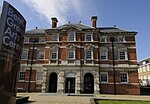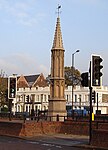The College of Haringey, Enfield and North East London
2009 establishments in England2009 in LondonAlumni of The College of Haringey, Enfield and North East LondonEducation in the London Borough of EnfieldEducation in the London Borough of Haringey ... and 3 more
Educational institutions established in 2009Further education colleges in LondonFurther education colleges in the Collab Group
The College of Haringey, Enfield and North East London (CONEL) is a college of further and higher education in North London, England. The current college was founded in 2009 as a result of a merger between Enfield College and The College of North East London (Conel). The college has centres in Tottenham and Enfield and draws its students mainly from the boroughs of Haringey, Enfield, and Hackney, Since 2017 the college is a part of Capital City College Group (CCCG) alongside City and Islington College and Westminster Kingsway College.
Excerpt from the Wikipedia article The College of Haringey, Enfield and North East London (License: CC BY-SA 3.0, Authors).The College of Haringey, Enfield and North East London
Town Hall Approach Road, London Tottenham (London Borough of Haringey)
Geographical coordinates (GPS) Address Nearby Places Show on map
Geographical coordinates (GPS)
| Latitude | Longitude |
|---|---|
| N 51.5869 ° | E -0.0717 ° |
Address
Town Hall Approach Road
Town Hall Approach Road
N15 4RY London, Tottenham (London Borough of Haringey)
England, United Kingdom
Open on Google Maps







